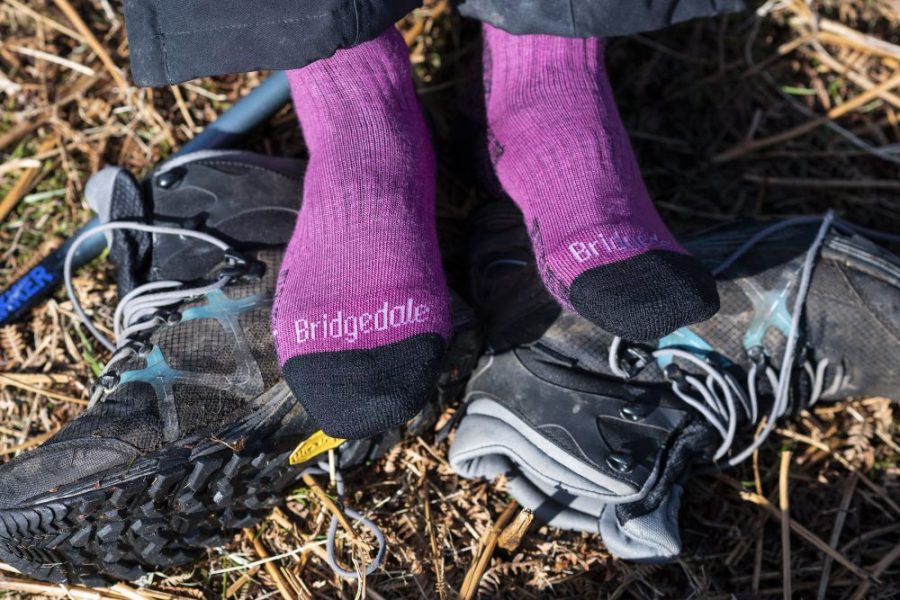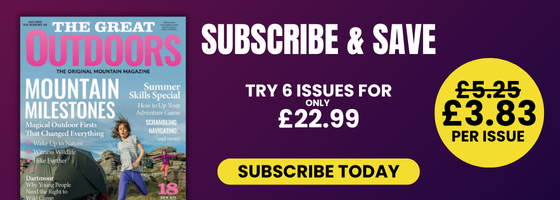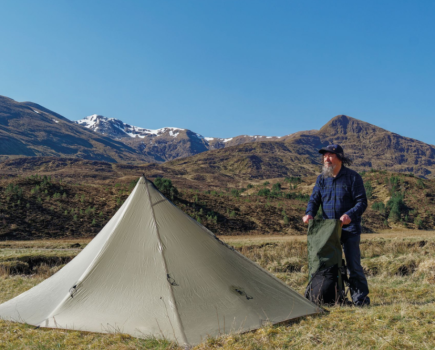Walkers have an intimate and complicated relationship with socks. If we choose correctly, socks are our invisible companion that protects us over the miles, a cushion between us and the footwear that takes the hits from rough trails, rocks, snow and mud all day. If we choose wrong, it can be nothing short of misery; wet feet that chafe, loose ankles that slip down and wrinkle inside a boot cuff, or seams that rub across the toes. Over the decades I’ve come to prioritise socks on a day out; if my feet are feeling okay, the rest of me can usually follow them home with a smile.
Main image: Gemma testing the Bridgedale Comfort sock | Credit: Ed Smith
In the past, the only choice was thick wool socks with looped inner stitches for cushioning. Modern synthetic fibres are now more common, and designs have become ever more complicated, from trail running ankle highs to zoned cushioning knee highs for winter climbing. Through all of this, some fundamental design principles have remained: comfort, fit, sweat management, temperature regulation and durability. Wool has always been a good choice for socks, offering temperature regulation and odour control, and now we see the finer grade of merino wool commonplace alongside synthetics like polyester and acrylic, which bring durability and moisture management.
Many models mix these fibres to bring the different performance elements together. But whatever the fabric, the sock must still fit well and sizing must be right for you – and this won’t always be the size it says on the tag! Check for a flat toe seam, along with the leg width to see if it’s too tight or too wide – both can cause problems. In footwear reviews we usually recommend taking your own socks to try out footwear in the shop – that tells you how important a good, well-fitting sock is.
Why you can trust The Great Outdoors
The Great Outdoors is here to help you make the most of your time outside. We have been helping people to explore from sea to summit, valley to mountain top for over 40 years. Our gear tests remain completely impartial. If you are wary of websites that only review brands that advertise with them, or sceptical of social media accounts always singing the praises of their latest freebie, you’ve come to the right place! Our reviews rank #1 for rigour, trustworthiness, and independence, and our gear testing team is the most experienced in Britain. With over 200 years’ experience between us, we are professional mountain leaders and instructors, wildlife photographers and rangers, outdoor authors, guidebook writers and trail addicts. Find out more about how we test.
The best hiking socks we’ve tested
In this article you’ll find our selection of the best pairs of socks for three-season hiking and trekking this year. The tests were conducted Gemma Palmer and Peter Macfarlane with additional testing from Lara Dunn and Chris Townsend. Testers focussed on the comfort, performance, durability, sustainability and value of each pair. All pairs have been hiked in and worn casually over extended periods.
| Quick List |
|---|
| Best for wet walks: Highlander Aqua-tac 100% waterproof socks (available from Highlander) |
| Best for comfort: Silverpoint Alpaca Merino Wool Hiker socks (available from Outdoor Action) |
| Best for durability: Darn Tough Hiker Micro Crew (available from Wild Bounds) |
| Best for fit: Falke TK2 Explore Women Trekking Socks (available from Falke) |
| Best all-rounder: INOV8 Merino High Sock (available from INOV8) |
Best for wet walks
Highlander Aqua-tac 100% waterproof socks
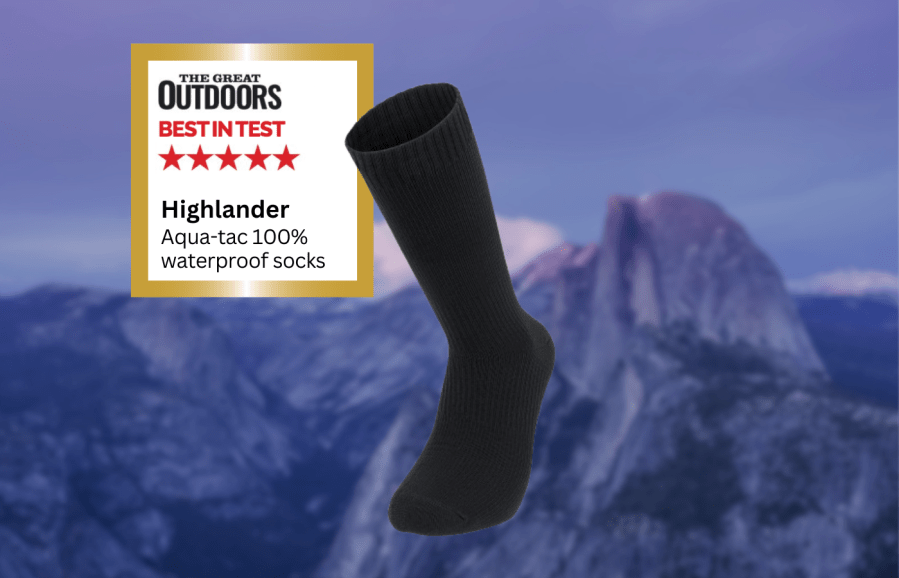
Gemma Palmer’s Best in Test
Overall, these socks are ready to tackle wet conditions. I recommend them for their performance and value in providing foot protection against wet conditions and cold temperatures without experiencing- temperature regulation
- excellent waterproofing
- breathability
- proper care essential to maintain the waterproof membrane
| Quick specs |
|---|
| Price: $53 / £39.99 Weight: 168g (size M) Materials: Outer Sock: 91% Nylon, 9% Elastane; Membrane: Waterproof, Breathable Hydrophilic Inner Sock: 41% Merino Wool, 44% Acrylic, 14% Nylon, 1% Elastane Sizes: UK 5 – 13 Men’s version: Unisex highlander-outdoor.com |
These Highlander Aqua-tac 100% waterproof socks gave me the confidence to take on the wettest routes. These socks gave me the confidence to take on the wettest routes. The fit is snug with a stretchy cuff that holds securely and comfortably without restricting circulation. The merino wool inner layer is soft against the skin, providing excellent warmth and keeping feet warm even when walking through wet blades of long grass and flooded fields.
Understandably, this thick knitted sock’s outer layer remains damp. Initial droplets and splashes of water roll away, but muddy water and heavy mud cling to the sock. This is easily removed by wiping away or brushing off once dry. Importantly, feet remain comfortable and do not overheat despite the added warmth of the merino wool. These socks kept feet dry from the ankle down during lashing rain.
Overall, these socks are ready to tackle wet conditions. I recommend them for their performance and value in providing foot protection against wet conditions and cold temperatures without experiencing wet feet or clamminess.
Read more: Gemma’s full Highlander Aqua-tac 100% waterproof sock review
Best for comfort
Silverpoint Alpaca Merino Wool Hiker socks
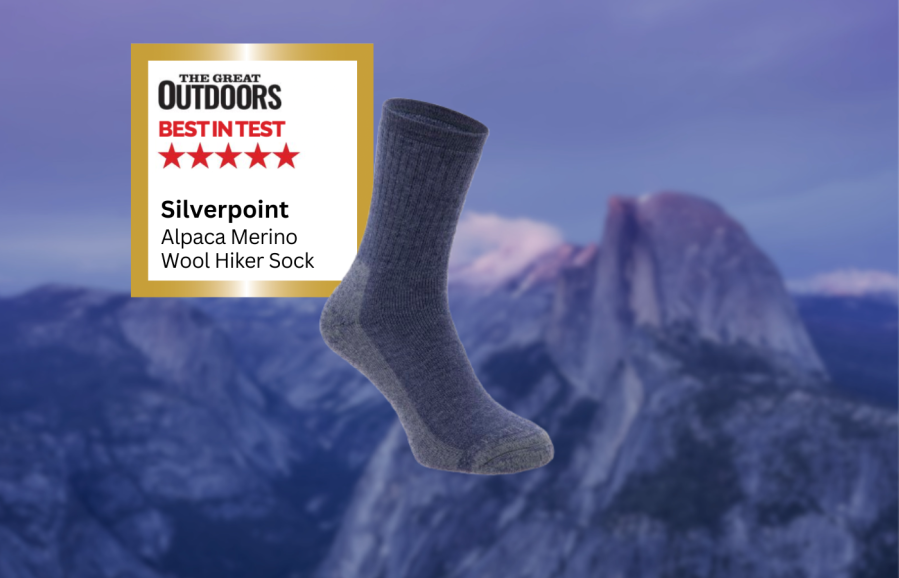
Peter Macfarlane’s Best in Test
The Hiker is marginally the most expensive sock in my test selection, but easily the most comfortable.- excellent comfort
- cost
| Quick specs |
|---|
| Price: $25 / £18.99 Weight: 92g pair, size large Materials: 15% Alpaca Wool, 45% Merino Wool, 20% Acrylic, 15% Polyamide, 5% Elastane Sizes: S, M, L, XL Men’s version: Unisex Available from Outdoor Action |
Alpaca wool is now a common enough resource to be used in socks, and it’s softer, stronger and warmer than merino, too, due to its hollow fibres. Merino still wins on moisture management, wider availability and therefore cost, so Silverpoint have mixed those two natural fibres together along with some synthetics which make up 40% of the socks’ structure.
In use, this mix makes for a luxuriously soft and comfortable sock. The Hikers’ comfort hasn’t come at the cost of durability, and the internal padding loops still spring back well after many wear/wash cycles. The outer surface has developed a light web of loose fibres, which haven’t affected performance and I’ve left alone.
The Hikers’ have a pleasant amount of comfort and warmth in both trail shoes and boots and I’ve been happy enough above the snowline in them as well as ankle deep in bog on my local trails. They remain warm when wet and dry out well on the move. I feel they maintain better cushioning when wet as well. I can happily wear the Hiker’s for a week between washes and even after a couple of days wear, I can dry them out, beside me in the sleeping bag, without wanting to throw them back outside!
Read more: Peter’s full Silverpoint Alpaca Merino Wool Hiker socks review
Best for durability
Darn Tough Hiker Micro Crew
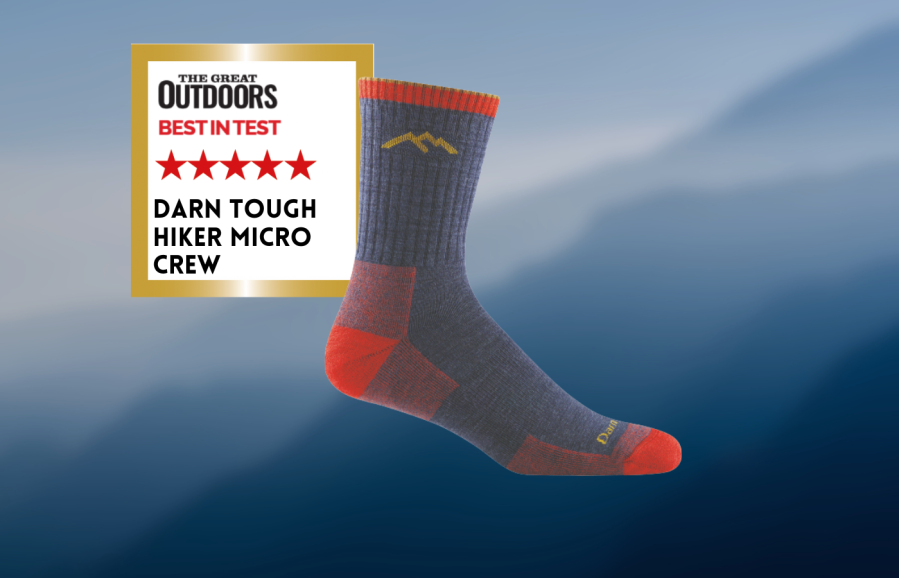
Chris Townsend’s Best in test
Darn Tough has built its reputation on durability and in my experience it’s well-earned- Tough
- Comfortable
- Six sizes
- None
| Quick specs | |
|---|---|
| Price | £28 |
| Weight | 76g |
| Materials | 61% Merino Wool, 36% Nylon, 3% Lycra Spandex |
| Sizes | 2.5 – 4.5, 5-7, 7.5-9, 9.5-11.5, 12-14, 15-16 |
| Versions | Women’s available |
| Brand site | https://darntough.uk |
Darn Tough hiking socks are known for their durability and comfort. The Hike/Trek Micro Crew socks are ideal for year-round use, except in cold weather. They have excellent fit, terry loop cushioning, and a stretchy top and rib-knit leg. Made from 61% merino wool and 36% nylon, these socks meet the Responsible Wool Standard and are made in Vermont, USA. The socks are made with enough wool to maintain their advantages, and are ideal for multi-day walks in the hills.
Read more: Chris Townsend’s full 2024 Darn Tough Hike/Trek Micro Crew Midweight review
Best for fit
Falke TK2 Explore Women Trekking Socks
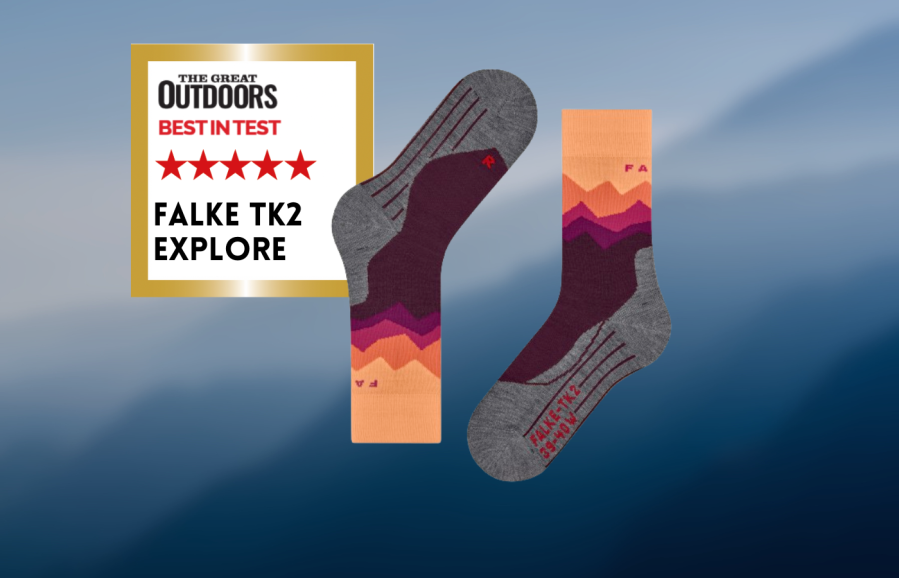
Lara Dunn’s Best in test
Costing very slightly more than most of the other socks I’ve tested, it marks an investment but it’s one that pays off for ongoing on-trail comfort.- Anatomically shaped left and right feet
- Technical fit and fabric
- Versatile weight
- On the pricy side
| Quick specs | |
|---|---|
| Price | $29 / £28 |
| Weight | 50g |
| Materials | 43% polypropylene/22% polyamide/19% acrylic/16% wool |
| Features | 3 layer construction, medium padding, anatomic left and right foot shape |
| Sizes | EU35-42/UK2.5-8 |
| Versions | Men’s available |
The Falke TK2 Explore mid-weight all-purpose hiking socks are a technical blend of performance synthetics and 19% wool for extra comfort, temperature management, and longevity. Available in various colors and sizing options across four narrow size bands, they are perfect for walks and treks.
The TK2 Explore is suitable for all but genuinely cold conditions and offers reliable fit, enduring comfort, and wash-after-wash durability. The female-specific version features a narrower fit than the men’s version, offering plenty of wiggle room and a secure fit with minimal bunching of fabric. The socks are on the shorter side but still long enough to fit securely above boot cuffs. Underfoot and heel cushioning levels are sufficient for long walks with a weighty pack, and the blend of synthetics and merino prevents sweat build-up and chafing, minimizing the risk of blisters.
The Falke TK2 Explore is capable of more challenging walks and works well with various outdoor footwear types. It is neither too thick nor too thin, making it suitable for year-round use. Although slightly more expensive than most other socks tested, it pays off for ongoing on-trail comfort.
Read more: Lara Dunn’s full 2024 Falke TK2 Explore Women Trekking Socks review
Best all-rounder
INOV8 Merino High Sock
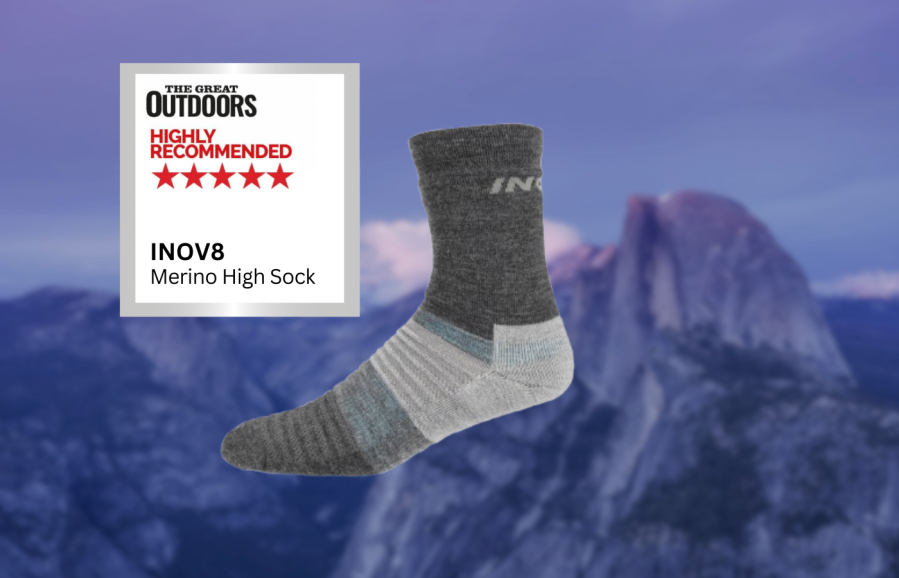
Gemma Palmer highly recommends
It’s a premium product at a reasonable price that delivers on every level, offering exceptional comfort, performance, and durability. Highly recommended for seeking the ultimate in day sock comfort.- reasonable price
- lightweight but warm
- fit
- odour control
- Prone to pilling
| Quick specs |
|---|
| Price: $17 / £12.50 Weight: 69g (size M / UK 6 – 8) Materials: 60% Merino Wool, 35% Polyamide, 5% Elastane Sizes: UK 3 – 14 Men’s version: Unisex www.inov8.com |
Slipping the INOV8 Merino High Sock on is an experience in itself. The initial feel is unlike any other sock I’ve worn. The soft, almost silky feel against my skin combined with a fine-knit construction creates an incredibly smooth, luxurious and seamless feel. They hug your feet comfortably without any restriction, allowing for unrestricted movement and circulation. Despite their lightweight nature, these socks provide impressive warmth from the outset, keeping your feet comfortable even in cooler conditions.
The sock has incorporated channelled cushioning across the top of the foot, offering crucial protection against downward pressure and the chafing that can sometimes occur from shoe tongues or laces. The inclusion of 60% merino wool, the highest amount we tested, lifts these socks to a new level of performance for a lightweight sock. Merino wool is renowned for its exceptional odour resistance, temperature regulation, and natural warmth.
I was pleasantly surprised that after airing out, the odour from my walking boots was gone, and I was ready to go again with a fresh pair of boots. It’s a premium product at a reasonable price that delivers on every level, offering exceptional comfort, performance, and durability. Highly recommended for seeking the ultimate in day sock comfort throughout the year.
Read more: Gemma’s full INOV8 Merino High Sock review
1000 Mile Men’s Fusion Repreve Double Layer Walking socks
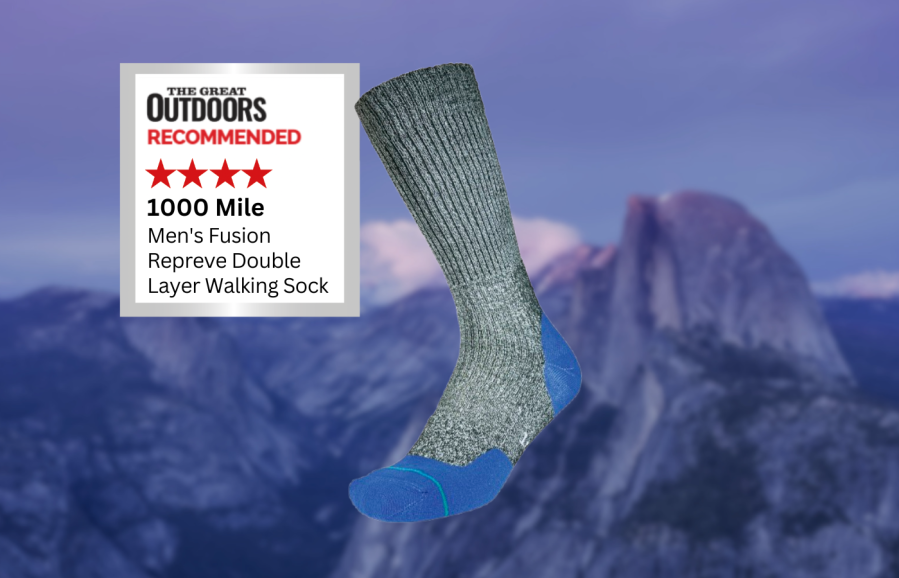
Peter Macfarlane recommends
Intended for use from autumn to spring, I’ve found the extra warmth of the double layer makes them suited to cooler months, but during milder days on lower-level trails, they haven’t overheated- comfort
- especially when wet
- leg is a little tight
- cost
| Quick specs |
|---|
| Price: $25 / £18.50 Weight: 112g pair, size large Materials: Outer layer: 30% merino wool, 46% nylon, 23% cotton, 1% elastane Inner layer: 100% Tactel Sizes: S, M, L, XL Women’s version: Yes 1000mile.co.uk |
They are intended for use from autumn to spring and I’ve found the extra warmth the double layer brings does make them suited to the cooler months, but during long milder days on lower-level trails, they still haven’t overheated.
I’ve worn them above the snowline in lighter boots with microspikes and they performed well. In trail shoes in cold and icy conditions the Fusions have been excellent – comfortable and warm even when both feet have been submerged and I’ve dried them out again quickly on the move.
They work well for bog hopping trips, with the inner layer keeping grit away from the skin. The merino content does help with odour resistance, but I avoid the Fusions for extended trips, since the layers trap dirt and odours quite readily.
The fit is unusual, the synthetic inner fits in place before the outer as the two skins are joined only at the toe and the cuff. This gets more noticeable after many washes as the sock crumples in the wash, but after many months of wear/wash cycles it always pulls smooth again.
However, the fit does work for me – it feels very close which I got used to quickly. It has decent cushioning at high impact points, a smooth toe seam and a stretchy cuff – this might feel tighter if you have larger calves and ankles.
Read more: Peter’s full 1000 Mile Men’s Fusion Repreve Double Layer Walking socks review
Bridgedale Women’s Heavyweight Merino socks
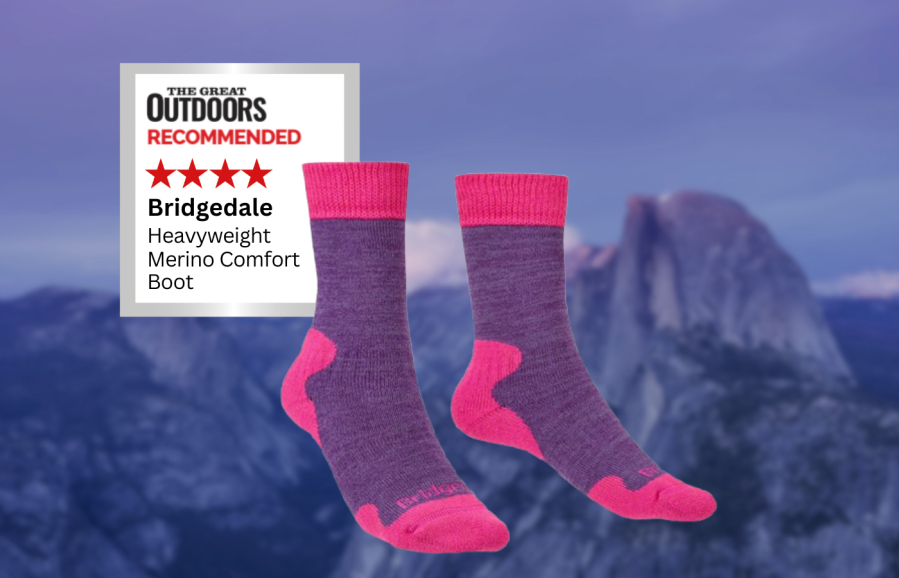
Gemma Palmer’s Greener Choice
These socks are ideal for day hikes and multi-day trips, with enhanced technology for shock zones and odour control.- sole cushioning
- stretch to fit cuff
- multi-day ready
- lack of initial warmth
| Quick specs |
|---|
| Price: $37 / £28 Weight: 3g size L (UK 7 – 8.5) Materials: 30% Merino Wool , 45% Coolmax® / polyester , 24% Nylon / polyamide , 1% LYCRA® / elastane Sizes: UK 3 to 8.5 Men’s version: Yes www.bridgedale.com |
Honestly, I was a bit worried about my feet staying warm in the sub-zero temperatures, and these Bridgedale Women’s Heavyweight Merino socks aren’t the best for the instant warmth I was looking for when I first put them on. A little cold at first but thankfully, they quickly warmed up and stayed toasty throughout the day, allowing me to enjoy the satisfying sensation of crunching frozen grass, mud, and the occasional icy puddle beneath my feet without a hint of cold seeping in.
The softness and cushioning quickly won me over. I usually prefer compression socks or those with elasticated cuffs to prevent slouching and support my feet. However, I was pleasantly surprised by how well these socks worked. The cushioning proved invaluable on the varied terrain, providing ample support and minimising impact. I was comfortable all day – no blisters, no tired feet, and no sweaty discomfort.
Initially, I was sceptical of the casual knit cuffs, but they stayed securely in place without feeling restrictive. These socks are ideal for day hikes and multi-day trips, with enhanced technology for shock zones and odour control. They hand wash well and dry quickly, ready for the next day’s adventure or to be rotated with other socks.
Read more: Gemma’s full Bridgedale sock review
EDZ Merino Lightweight Walking socks
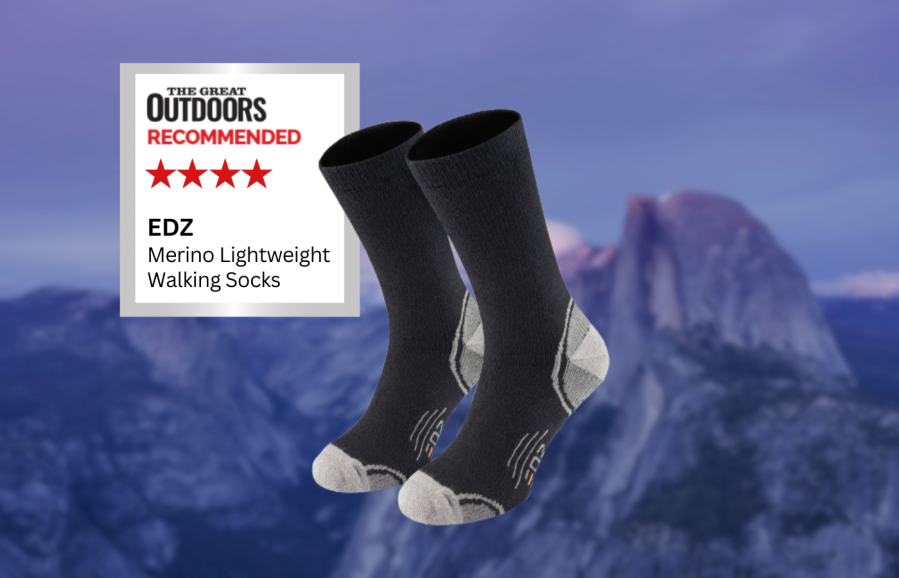
Peter Macfarlane recommends
The high merino content means even after a week’s wear the Lightweights have been wearable, and they freshen up reliably after a wash.- simple and effective at a good price
- a few loose thread loops inside
| Quick specs |
|---|
| Price: $17.50 / £12.99 Weight: 83g pair, size large Materials: 50% Merino, 25.% Polyester, 20% Nylon, 5% Elastane Sizes:UK 3-5, 6-8, 9-11, 12-13 Women’s version: Unisex edz.co.uk |
The EDZ Merino Lightweight Walking socks feel and look very understated with a simple mainly black design. EDZ say that the Lightweight’s are an evolution of their running sock, and they are noticeable lighter than the brand’s heavier boot offering, but the higher ankle definitely puts them in the walking sock bracket. The fabric is well suited for all round performance with 50% merino wool for comfort and odour resistance and synthetics for shape and durability. The inside is evenly padded throughout, and the loop stitches are still bouncing back quite well after many miles and consequent washes.
They dry quickly on the move and remain chafe-free, if perhaps a little cooler in similar conditions compared to the other socks in my test selection. The high merino content means even after a week’s wear the Lightweights have been wearable, and they freshen up reliably after a wash.
The price is very good for a merino sock so despite one issue with inner stitching, they retain a high 4/5 score.
Read more: Peter’s full EDZ Merino Lightweight Walking socks review
How we tested the best hiking socks
Gemma, who is 5’10” tall and wears a UK size 8.5 shoe, experiences cold toes during winter hikes. She has a wide forefoot, high arch, and narrow heel. Gemma wore the socks paired with leggings when hiking across the diverse terrains of East Anglia, including coastal trails, nature reserves, heathlands, and riverbanks.
Peter has a size 9UK foot with low-ish volume, a wide forefoot and a narrow heel and ankle. His feet tend to stay an even temperature across the seasons. He used the test socks over an extended period in all seasons and conditions in various footwear on trail and hillwalks as well as for extensive everyday use.
Lara tested her socks in the Malvern hills, Black Mountains and Brecon Beacons in late autumn and wet winter conditions. She is a Size 39/5.5 with a medium forefoot and narrow heels
Chris tested his socks during last autumn and early winter in a variety of footwear ranging from mesh trail shoes to boots with gaiters. To compare the socks he wore different ones of similar thickness on each foot and then compared them afterwards for dampness, fit and matting.
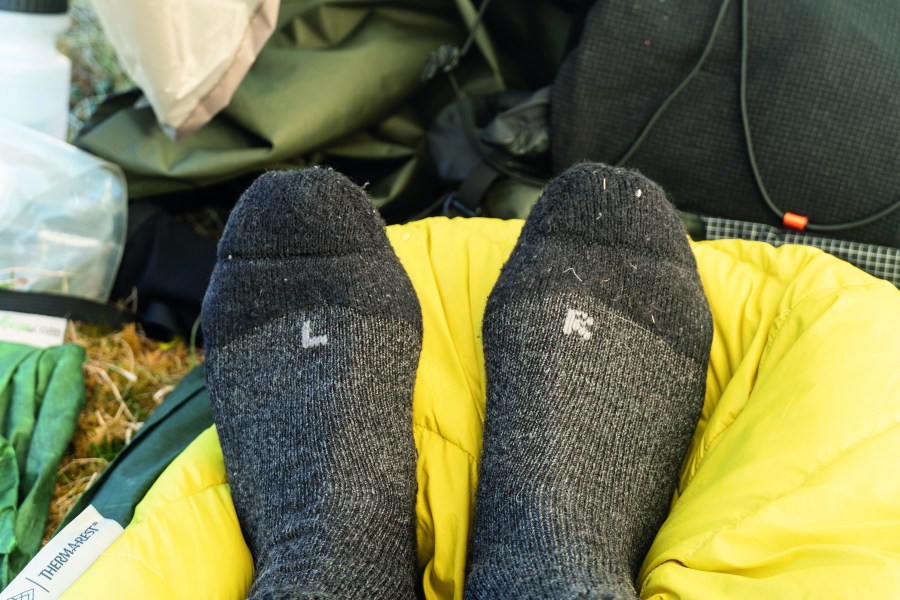
How to choose hiking socks
From how to judge if a sock will be comfortable before you buy it, to how to pick socks that will last you a lifetime, here’s all you need to know about hiking socks and how to choose the right pair for your adventures.
Anatomy of a sock
Designing a hiking sock requires careful consideration of the cuff, ankle, instep, heel, foot, sole, toe, and knitting techniques to ensure a smooth and comfortable fit. Anatomically shaped arches offer support and stability, reducing fatigue and enhancing comfort on challenging hikes. Seamless toe seams and reinforced stress points minimise friction, further reducing the risk of blisters. This combination of features results in socks that provide optimal comfort, support, and protection.
Matching weight to conditions
Hiking socks come in various weights, each suited for different conditions; there are general assumptions for the four weights: Ultralight socks (40-60 grams) are ideal for warm weather and offer minimal cushioning; Lightweight socks (60-80 grams) provide light cushioning and are suitable for moderate conditions; Midweight socks (80-100 grams) offer moderate cushioning and are ideal for three-season hiking; Heavyweight socks (100+ grams) provide maximum cushioning and are designed for cold weather and challenging terrain. Choosing the right weight depends on factors like weather, terrain, and personal preference.
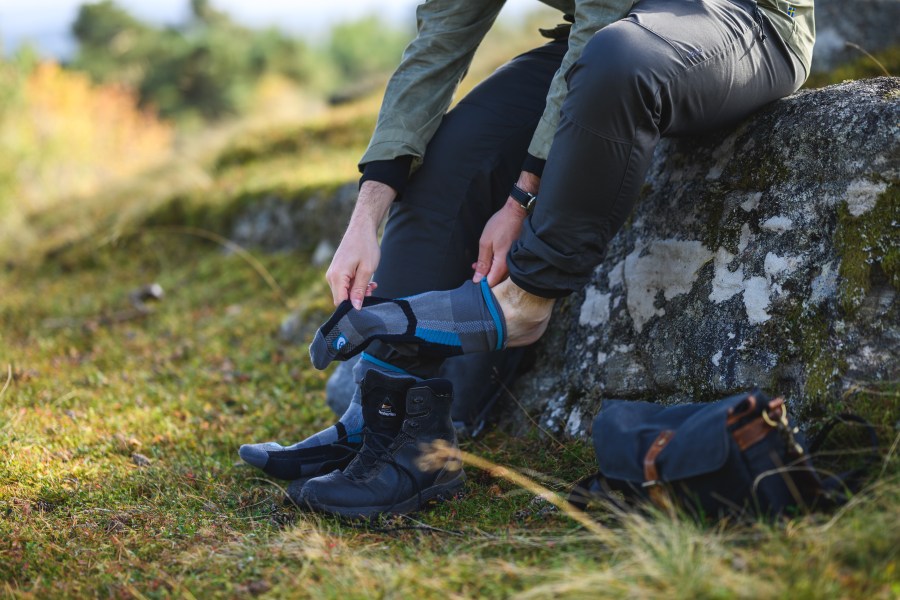
Materials
Most socks are made from merino wool, nylon or polyester and the best material for hiking socks tends to be a blend of these fibres. They’ll then also have a bit of elastane for stretch. The benefits of nylon and polyester synthetic fibres are that they are very quick-drying and hard-wearing. Merino wool, on the other hand, is a natural fibre that stays warm even when wet and it tends to be naturally odour-resistant and very comfortable. What’s more, merino is able to wick moisture away from the skin, helping to keep your feet dry in clammy conditions.
The downsides are that merino is an animal product, and there are instances of animal cruelty in the merino wool industry. Fortunately, however, most products in the outdoor sector now certify their merino wool. It’s always worth checking the details though.
Socks with high merino content of, say, above 75% will tend to be a little more fragile and not as long lasting as socks with a higher proportion of synthetics. So, ideally, the best hiking socks will have a high merino content of around 65% and then a good mix of synthetics and elastane.
It’s generally best to avoid cotton socks for hiking as it’s very absorbent and slow drying. Once your feet get wet in cotton socks, they’ll tend to stay wet and over time this could cause blisters and other problems.
New to the scene are socks made from bamboo. This sustainable material tends to create socks that are very comfortable against the skin and it also contains an antibacterial and anti-fungal agent called “bamboo kun,” which helps to prevent foot odor and infections. The downside to bamboo socks is that they may not be as durable as other hiking socks made from synthetic materials or a blend of merino and synthetics. Also, like cotton, the material is moisture absorbent and slow to dry.
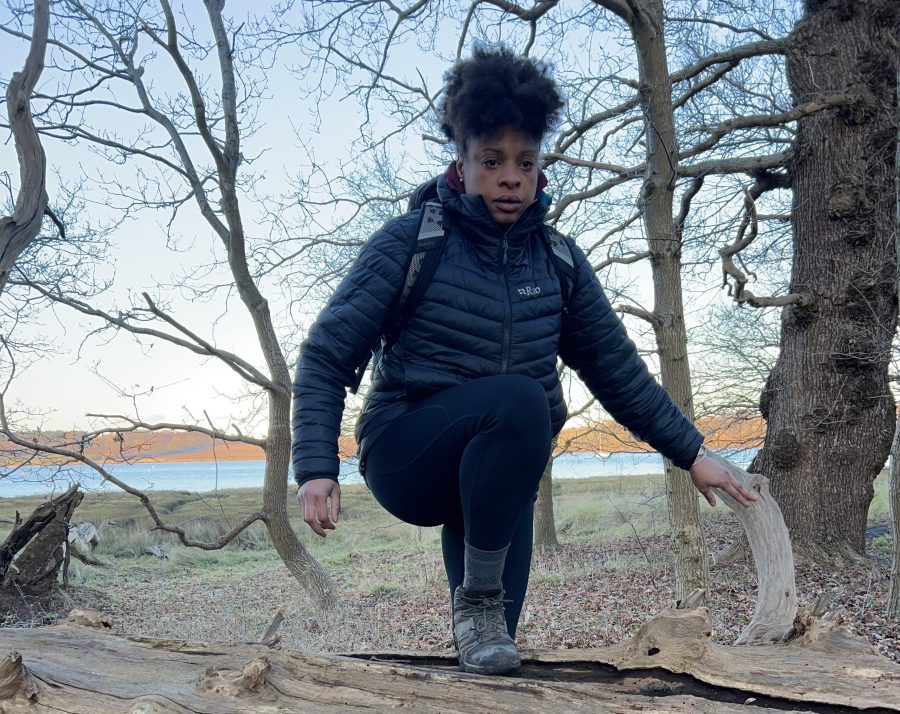
Thickness
If you’re looking for maximum warmth, say, for winter hiking, look for socks with a high wool content and thick yarns. If you want breathability, look for socks with thinner yarns and a light weave.
Choosing between thick or thin socks for hiking involves considering various factors. Thick socks offer extra cushioning, padding, and insulation for cold weather hikes, but may affect boot fit and trap more heat in warmer conditions. Thin socks are lightweight, breathable, and provide a closer fit, suitable for hot weather or intense activities, but may offer less protection and cushioning. We recommend that hikers should consider personal comfort preferences, weather conditions, terrain, and footwear type when making their choice. Proper boot fit is crucial, and hikers should experiment to find the right balance between comfort, protection, breathability, and weather conditions.
Some of the best socks for three-season hiking come with zoned areas to ensure comfort and breathability are provided in the right places. These socks will have a thin weave and potentially even some air channels stretching across the top of the foot, then a dense weave across the base and around the ankle.
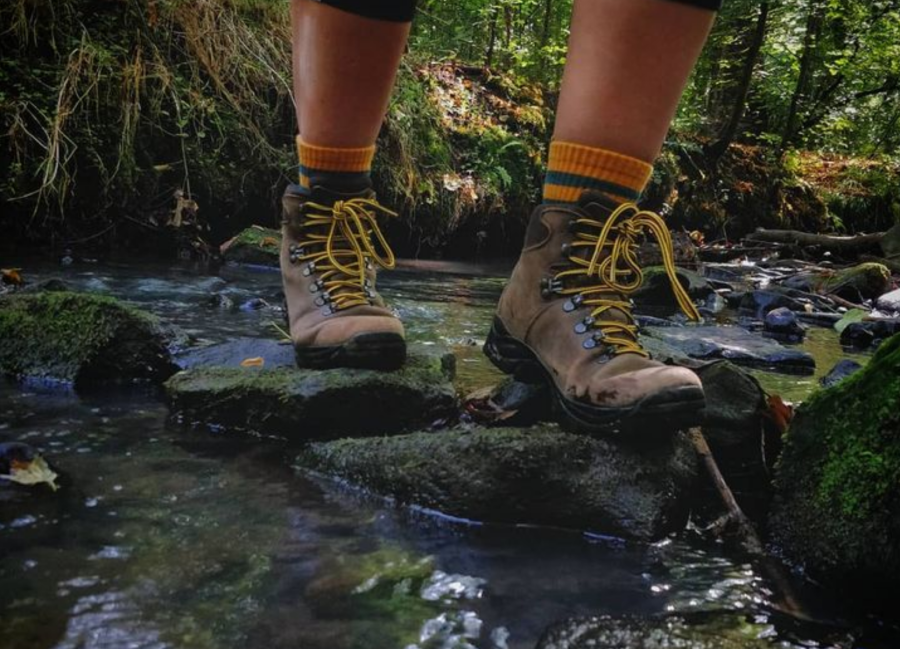
Height
Ankle-length, crew-length, and knee-high are the most common sock lengths for hiking. Ankle-length socks provide the least coverage and are best for hot weather, as they allow for maximum ventilation. These tend to suit hikers who prefer to hike in trail shoes.
Crew-length socks cover the ankle and extend up to the mid-calf, providing more protection from debris and rubbing from your shoes. This type of sock length tends to be the most common.
Knee-high socks offer the most protection, making them ideal for colder conditions and rough terrain. However, knee-high socks can be bulkier and may cause overheating in warmer conditions. Ultimately, the best sock length for your hike will depend on the weather, terrain, and your personal preferences.
Warranties
Some hiking socks, like those from Darn Tough, come with a lifetime warranty, meaning that the manufacturer will repair or replace the socks at any time for any reason. Other warranties may cover the socks for a specific period of time, such as a year, and may only apply to defects in materials or workmanship. Some warranties may not cover normal wear and tear or damage caused by improper use or care and some may require you to return the socks to the manufacturer for inspection.
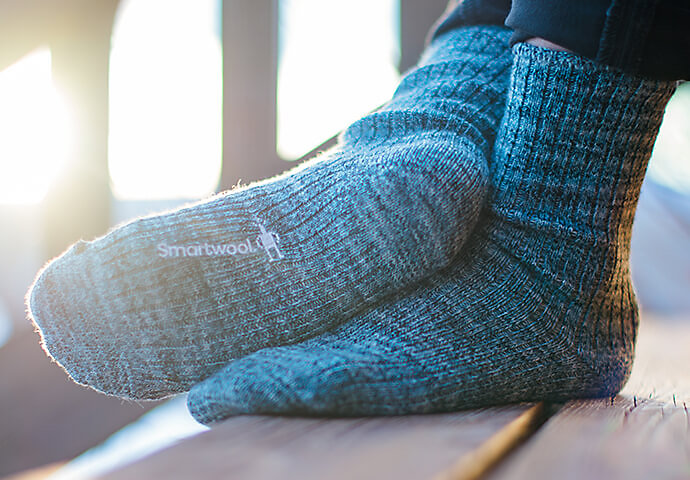
Features to look for in hiking socks
Materials
Merino wool is arguably the best material for socks, as it is comfortable, breathable, and quite warm when damp. Other wools aren’t quite as soft but still perform well. Wool can be worn for days on end without needing to be washed too. Nylon is usually added to wool socks at the toe and heel for abrasion resistance. Wicking synthetics such as Coolmax and polypropylene are good for the fast removal of moisture and are quick drying but need washing frequently.
Length
Socks should come high enough above boot tops that they can be folded down over them in hot weather. With trail shoes shorter socks can be worn though this can lead to cool ankles in cold weather.
Toe Seams
Toe seams should be set back from the end of the toes and should be flat so they don’t rub. Raised stitching over the tips of the toes is to be avoided.
Heels
The heels should be shaped so they fit round your feet without any loose material. Rather than a straight line of stitching there should be Y shaped stitching round the heel, known as a Y gore. Heel stitching should be flat so it doesn’t rub.
Cuffs
Elastic material at the cuff (Lycra, spandex, elastane) helps to stop the socks slipping down. Double cuffs with rolled-over tops are the softest and most comfortable.
Inner Construction
The warmest socks have terry loop construction throughout. Extra padding under the foot and at the heel and toes provides more cushioning and increases durability. Socks for warmer conditions often only have terry loop construction on the bottom and sides of the socks with flat or rib knitting on the upper foot and legs, as this is cooler.
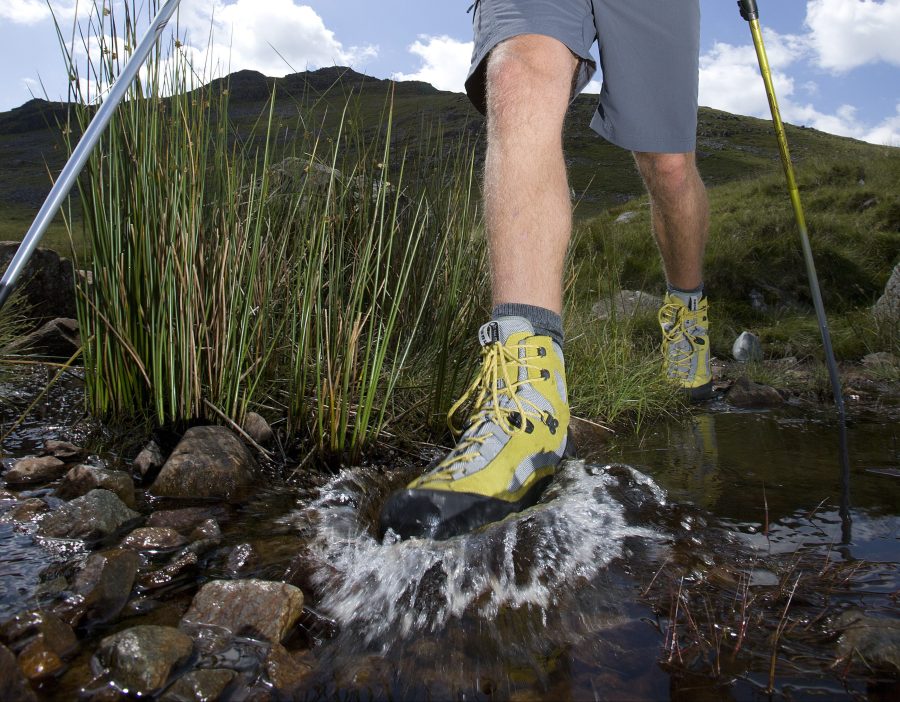
Can I hike in regular socks?
When you’re spending in excess of £100 for a pair of hiking boots that promise to be comfortable and breathable, are cheap supermarket socks really the best thing to be stuffed inside them, or should you finally admit that you might have to spend your annual sock budget on a decent pair of hiking socks? Let’s look at the pros and cons.
Regular Sock Pros
- Affordability: Usually cheaper, especially when bought in bulk.
- Ease of Care: Typically machine-washable and dryer-friendly.
Regular Sock Cons
- Moisture Retention: Materials like cotton can hold moisture, leading to discomfort and blisters.
- Lack of Support: Minimal padding and no arch support can make long hikes uncomfortable.
- Durability: Tend to wear out faster, especially when used in rugged conditions.
- Temperature Regulation: Less effective at keeping feet at a comfortable temperature.
Hiking Sock Pros
- Moisture-Wicking: Designed to pull moisture away from your feet, keeping them dry and comfortable.
- Additional Padding: Extra cushioning in high-impact areas like the heel and ball of the foot.
- Temperature Regulation: Breathable materials help to regulate foot temperature in various climates.
- Durability: Made with reinforced seams and high-wear areas to last longer.
- Arch Support: Some designs offer built-in arch support for added comfort.
Hiking sock cons
- Cost: Generally more expensive than regular socks.
- Specialised Care: May require specific washing instructions to maintain quality.
Your standard socks might be affordable, but they’re often not built to last, especially when faced with the great outdoors. Hiking socks, on the other hand, are designed with reinforced seams and tougher materials in high-wear areas like the heel and toe. It’s a bit like comparing a sturdy 4×4 to a city runaround; both will get you from A to B, but one is clearly better suited for rough terrain. After all, quality lasts longer than the memory of the price tag. Check out our guide to Best hiking socks to find out what pair you should pick up next.
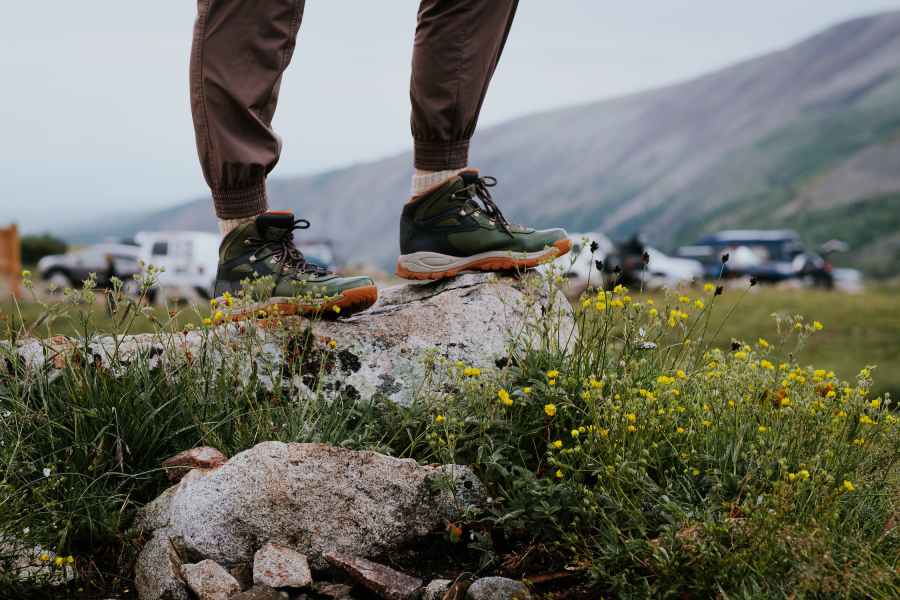
How do I choose the right size hiking socks?
You’ll need to consider your usual shoe and sock size when finding the right fit for you. Some outdoor shops such as Cotswold Outdoor offer an in-store measuring service and there are fitting services offered by specialists if you are unsure. But a good rule of thumb – or toe – is to stick to the sizing you’d wear everyday.
Most socks, especially those with stretch, are only sold in size categories encompassing a few different shoe sizes. A lot of brands, such as Smartwool, split sizes across two to three shoe sizes. You’ll need to consult the relevant size guide and guidelines for the sock in question to see whether they run true to size or whether you’ll need to size up or down.
If you’re looking for compression socks, you’ll also need to have your calf measurements to hand.

